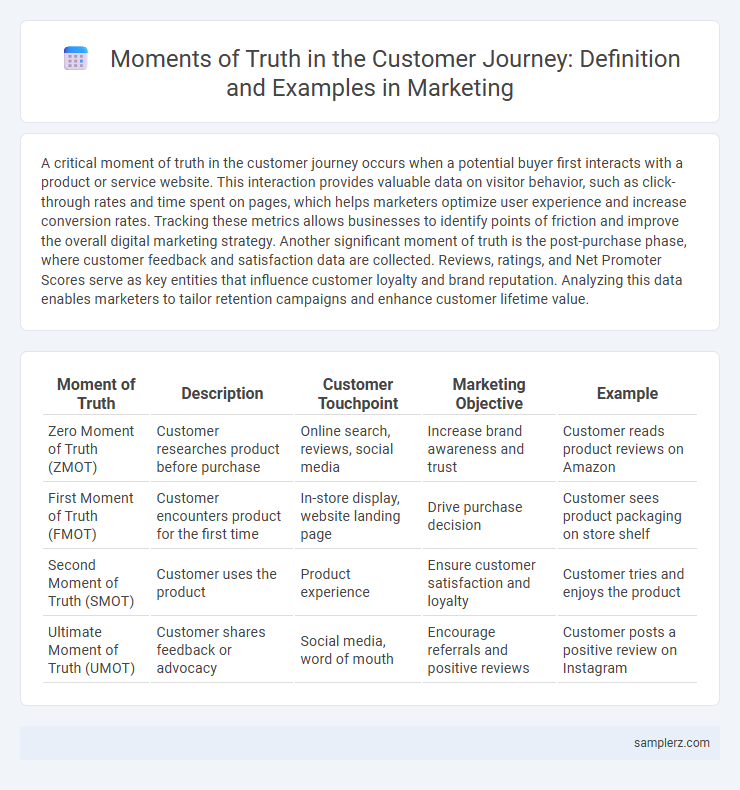A critical moment of truth in the customer journey occurs when a potential buyer first interacts with a product or service website. This interaction provides valuable data on visitor behavior, such as click-through rates and time spent on pages, which helps marketers optimize user experience and increase conversion rates. Tracking these metrics allows businesses to identify points of friction and improve the overall digital marketing strategy. Another significant moment of truth is the post-purchase phase, where customer feedback and satisfaction data are collected. Reviews, ratings, and Net Promoter Scores serve as key entities that influence customer loyalty and brand reputation. Analyzing this data enables marketers to tailor retention campaigns and enhance customer lifetime value.
Table of Comparison
| Moment of Truth | Description | Customer Touchpoint | Marketing Objective | Example |
|---|---|---|---|---|
| Zero Moment of Truth (ZMOT) | Customer researches product before purchase | Online search, reviews, social media | Increase brand awareness and trust | Customer reads product reviews on Amazon |
| First Moment of Truth (FMOT) | Customer encounters product for the first time | In-store display, website landing page | Drive purchase decision | Customer sees product packaging on store shelf |
| Second Moment of Truth (SMOT) | Customer uses the product | Product experience | Ensure customer satisfaction and loyalty | Customer tries and enjoys the product |
| Ultimate Moment of Truth (UMOT) | Customer shares feedback or advocacy | Social media, word of mouth | Encourage referrals and positive reviews | Customer posts a positive review on Instagram |
Understanding the Moment of Truth in the Customer Journey
The moment of truth in the customer journey often occurs when a potential buyer interacts with a product demo or reads user reviews, directly influencing purchase decisions. Analyzing these critical touchpoints through data analytics helps marketers tailor personalized experiences that enhance customer satisfaction and brand loyalty. Effective management of these moments requires integrating real-time feedback mechanisms to promptly address concerns and reinforce positive perceptions.
Why Moments of Truth Matter in Marketing
Moments of truth in marketing are critical touchpoints when customers form or change their perceptions about a brand, directly impacting loyalty and conversion rates. Positive experiences during key interactions, such as product trials or customer service encounters, significantly enhance brand trust and advocacy. Brands that strategically anticipate and optimize these moments increase customer satisfaction and drive long-term revenue growth.
First Impressions: The Zero Moment of Truth
The Zero Moment of Truth (ZMOT) occurs when potential customers first encounter a brand online through search engines, social media, or reviews, significantly influencing their purchase decisions. This initial digital interaction shapes customer perceptions before any physical engagement, serving as a critical touchpoint in the buyer's journey. Brands optimizing content for search intent and providing clear, trustworthy information at this stage can dramatically increase conversion rates and customer loyalty.
The First Interaction: First Moment of Truth Examples
The first interaction in the customer journey, known as the First Moment of Truth (FMOT), is critical as it shapes the consumer's initial perception of a brand or product. Examples include a shopper encountering an eye-catching product display in-store, a user landing on a homepage with clear, compelling value propositions, or receiving a personalized email that resonates with their needs. These touchpoints significantly influence purchase decisions and brand loyalty by creating immediate trust and interest.
Purchase Decisions: Second Moment of Truth Scenarios
The Second Moment of Truth occurs when customers use a product and assess its value against their expectations, heavily influencing repeat purchases and brand loyalty. For example, a skincare brand's customer deciding to repurchase after experiencing visible improvements validates the initial purchase decision. Positive experiences during this phase drive advocacy and reduce churn in the marketing funnel.
Post-Purchase Experiences: Third Moment of Truth Examples
Post-purchase experiences, or the Third Moment of Truth, occur when customers use and evaluate a product, influencing brand loyalty and advocacy. For example, personalized follow-up emails and proactive customer support enhance satisfaction and encourage repeat purchases. Effective use of social proof, such as user-generated reviews and testimonials, further strengthens customer trust and drives positive word-of-mouth marketing.
Digital Moments of Truth in Online Customer Journeys
Digital Moments of Truth in online customer journeys occur when users interact with brand touchpoints such as website landing pages, product videos, or live chat support. These interactions significantly influence purchasing decisions by providing instant information, building trust, and enhancing user experience. Effective optimization of these moments drives higher conversion rates and long-term customer loyalty.
Social Media’s Role in Moments of Truth
Social media platforms serve as critical moments of truth in the customer journey by shaping brand perception instantly through user-generated content and real-time engagement. Consumers rely on social proof from reviews, testimonials, and influencer endorsements available on social channels to validate purchase decisions. Brands leveraging targeted social media campaigns increase conversion rates by creating authentic interactions that build trust and loyalty at key decision points.
Real-World Case Studies of Moments of Truth
Amazon's "moment of truth" occurs during the checkout process, where a smooth, one-click ordering system minimizes friction and boosts conversion rates. Apple's retail experience exemplifies a critical touchpoint, with knowledgeable staff providing personalized product demonstrations that increase customer trust and sales. Starbucks captures moments of truth through its mobile app, enabling easy order customization and fast pickup, enhancing customer satisfaction and loyalty.
Leveraging Moments of Truth for Customer Loyalty
Leveraging moments of truth, such as the initial product unboxing or first customer service interaction, significantly impacts customer loyalty by creating lasting emotional connections. Brands that optimize these critical touchpoints through personalized experiences and responsive support increase repeat purchases and positive word-of-mouth. Data from Salesforce reveals that 70% of customers say connected processes influence their loyalty, highlighting the importance of mastering these decisive moments.

example of moment of truth in customer journey Infographic
 samplerz.com
samplerz.com